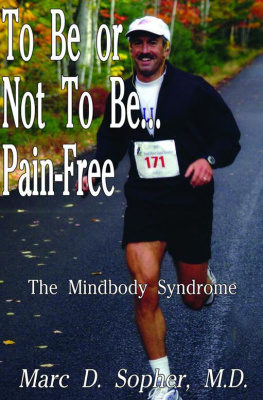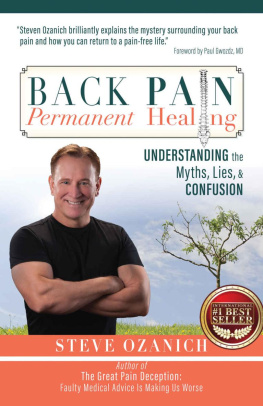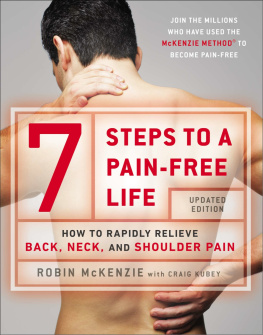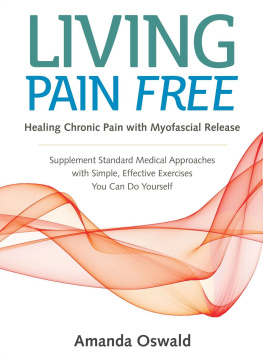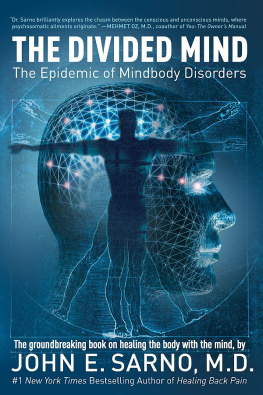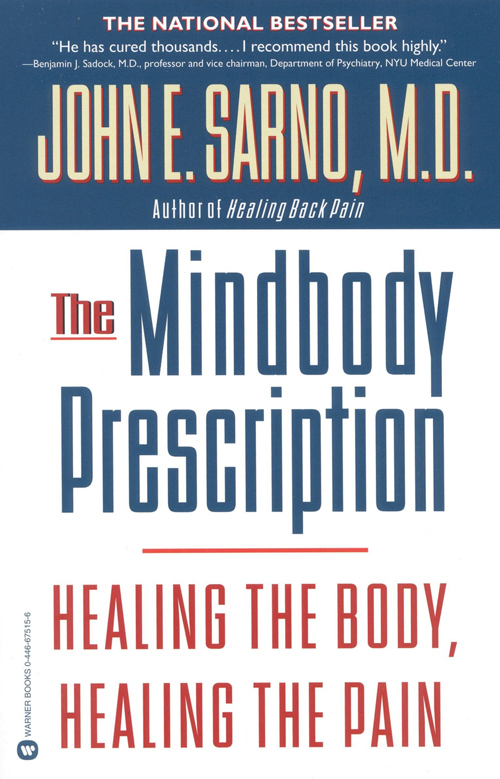The information herein is not intended to replace the services of a trained health professional. You are advised to consult with your health care professional with regard to matters relating to your health, and in particular regarding matters that may require diagnosis or medical attention.
THE MINDBODY PRESCRIPTION. Copyright 1998 by John E. Sarno, M.D. All rights reserved. No part of this book may be reproduced in any form or by any electronic or mechanical means, including information storage and retrieval systems, without permission in writing from the publisher, except by a reviewer who may quote brief passages in a review.
Warner Books,
Hachette Book Group
237 Park Avenue
New York, NY 10017
ISBN: 978-0-7595-2189-6
A hardcover edition of this book was published in 1998 by Warner Books.
First eBook Edition: March 2001
Visit our website at www.HachetteBookGroup.com.
Dedicated with gratitude and
affection to my patients:
the source of my knowledge
and the fount of my pleasure in
the practice of medicine.
I am indebted to these busy people who were kind enough to read and critique parts or all of the text: Frances Anderson, Jim Campobello, Stanley Coen, Arlene Feinblatt, Marion Hart, Ruth Imber, Ira Rashbaum and Eric Sherman. I am additionally grateful to the psychotherapists in this group who have worked with me through the years and contributed immensely to my understanding of the psychodynamics of the unconscious.
As a result of her illustrious career as medical author and editor, the suggestions of my wife, Martha Taylor Sarno, were extremely valuable.
I have been particularly fortunate in having found a sensitive, diplomatic and very effective literary agent in Alice Martell. Publication bumps were minimal, but she was most helpful in smoothing the few there were.
The editor of Healing Back Pain and original editor of this book was Susan Suffes, who was a joy to work with; along the way she decided on a career change and left Warner Books. However, fortune smiled on me once more when Susan Sandler became my editor. Susan is from the old schoolshe edits. I am most grateful for her stylistic and organizational changes and embarrassed by what some of the text would have looked like without her editing.
And finally, literally and figuratively, there is Mary Oland, my secretary, indefatigable typist and conqueror of the computer. I have marveled at her good humor in the face of innumerable changes and copies. Thank you, Mary.
Pain, disability, misinformation, fearthat quartet has plagued the Western world for decades and the plague shows no sign of abating. Back, neck and limb pain are rampant, and statistics indicate that the epidemic is spreading. Disability in American industry from low back pain continues to increase year by year.
Industries that employ large numbers of people working at computers are experiencing great disability and health insurance problems because of a new pain disorder known as repetitive stress injury (RSI). Millions of Americans, mostly women, suffer from a painful malady of unknown cause called fibromyalgia. While gigantic medical industries have arisen to diagnose and treat these conditions, the plague continues.
This book is about that epidemic. It describes both a clinical experience that has identified the cause of the pain disorders and a method of treating them. Sadly, mainstream medicine rejects the diagnosis because it is based on the theory that the physical symptoms are initiated by emotional phenomena. Intelligent laymen in large numbers have embraced the concept, however, no doubt because they are not burdened by the bias imposed by a traditional medical education.
As if the pain epidemic were not of sufficient magnitude, a large group of physical disorders have been identified as equivalents of the pain syndrome, since they appear to stem from the same psychological process. These maladies have occurred commonly for years and, taken together with the widespread pain maladies, are universal in Western society. I refer to many of the headaches, gastrointestinal symptoms and allergies, as well as respiratory, dermatologic, genitourinary and gynecologic conditions that are the stuff of everyday life.
If most of these are psychogenicthat is, they originate in the mind (and it is my goal to demonstrate that they are)we have a public health problem of staggering proportions. The medical, humanitarian and economic implications are obvious and will be enumerated.
This book is about emotions, illness and wellness, how they are related and what one can do to enhance good health and combat certain physical conditions. The ideas are based on twenty-four years of successfully treating an emotionally induced physical disorder known as the Tension Myositis Syndrome (TMS). Although I will provide an up-to-date description of that condition, my major focus is the impact of the emotions on bodily function.
That connection came close to being accepted by Western medicine in the first half of the twentieth century and then fell into almost total disrepute. Repudiation of psychoanalytic theory, increased interest in laboratory research and the tendency of doctors to shy away from psychological matters (they see themselves as engineers to the human body) are the likely reasons for this historical trend. As the century draws to a close, few practitioners, either in physical or psychological medicine, believe that unconscious, repressed emotions initiate physical illness. Psychoanalysts are the only clinicians who have held to that concept, but their influence in the larger fields of psychiatry and general medicine is limited. In the physical medicine specialties virtually no one adheres to the idea.
Despite the lack of interest of mainstream medicine, much has been written on the mind-body connection. Careful studies have been conducted that relate psychological factors to pathological conditions such as coronary artery disease and hypertension. I know of only one investigator outside the field of psychoanalysis who has identified unconscious emotions as the cause of a physical illness. One reads of stress, anger, anxiety, loneliness, depression, but they are discussed as conscious, perceived emotions. In many instances these feelings are thought to aggravate underlying structural pathological processes, such as herniated discs, fibromyalgia or repetitive stress injury.
In view of the widespread Freud-bashing of recent years I may be courting disapproval to state that my concepts descend from Freuds clinical observations and theories. But I know this only in retrospect, for I did not set out to prove Freud right. My developing ideas were the consequence of clinical observations; they were not based on preconceived notions about the mindbody connection. As with Freuds patients, I found that my patients physical symptoms were the direct result of strong feelings repressed in the unconscious. In addition, I have drawn on the concepts of three other psychoanalysts: Franz Alexander, founder of the Chicago Institute for Psychoanalysis, did pioneer work in mindbody medicine in this century; Heinz Kohut conceptualized what is known as Self Psychology and pointed out the importance of narcissistic rage; Stanley Coen suggested the crucial idea that the mindbody disorder I was studying (TMS) was a defense, an avoidance strategy designed to turn attention away from frightening repressed feelings.
This book addresses physical disorders that are caused by repressed, unconscious feelings. Because these disorders are very specific, they can be accurately diagnosed and successfully treated.


